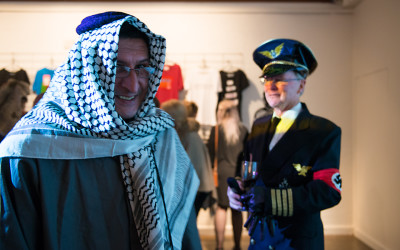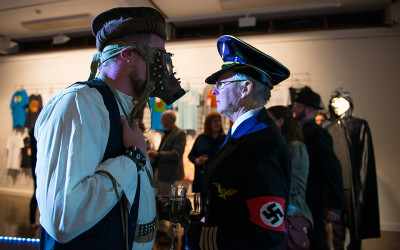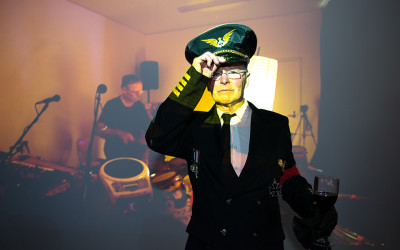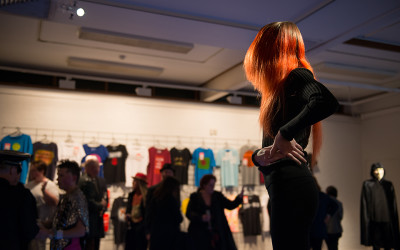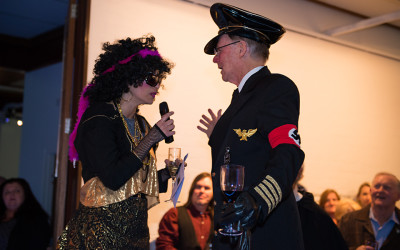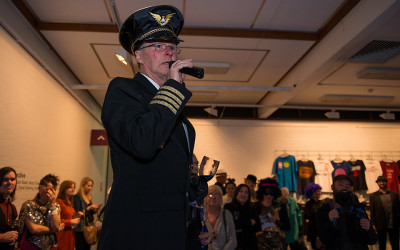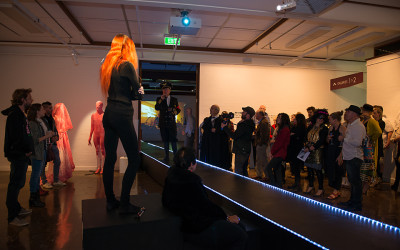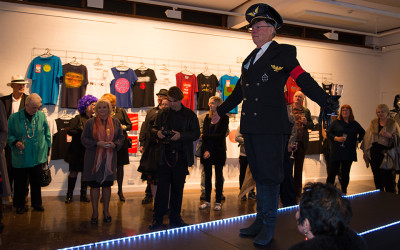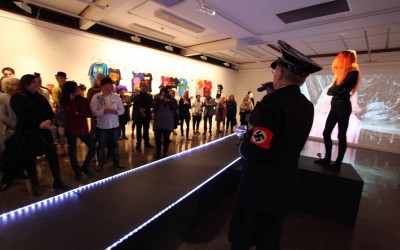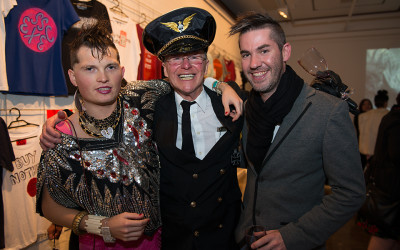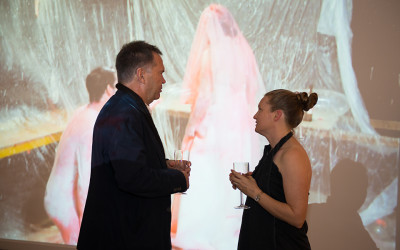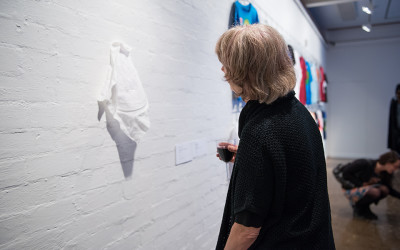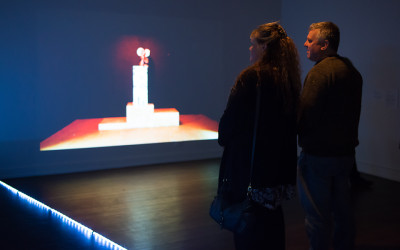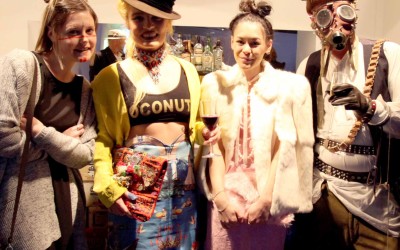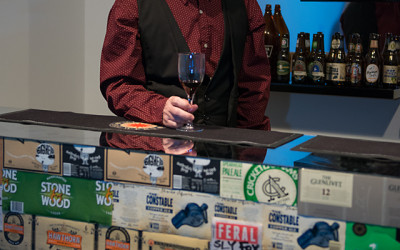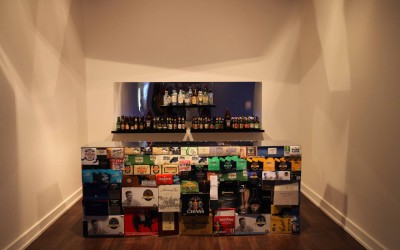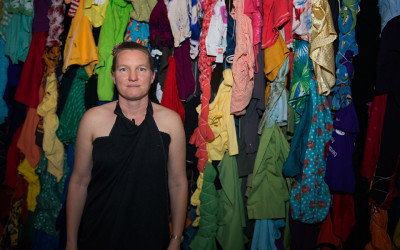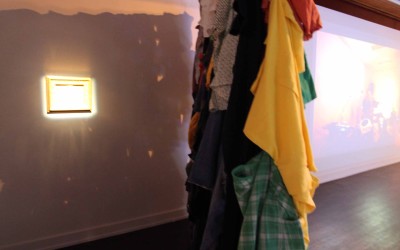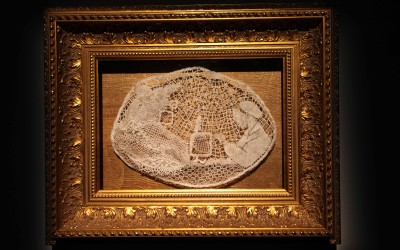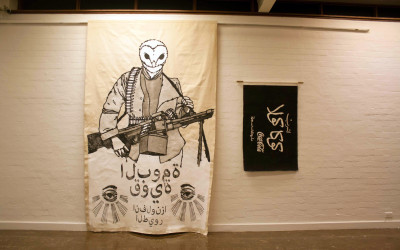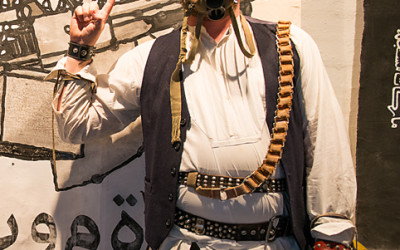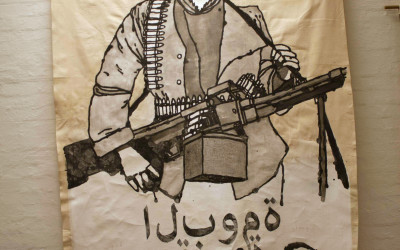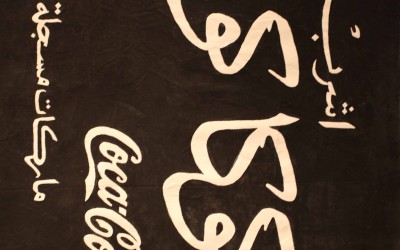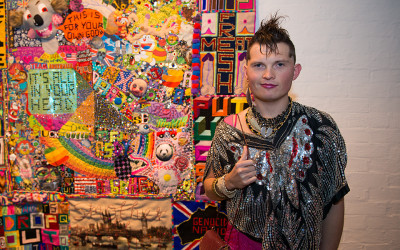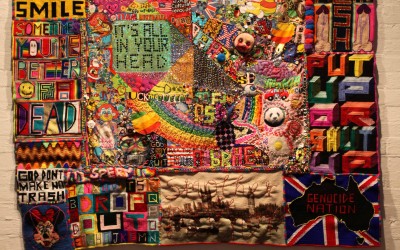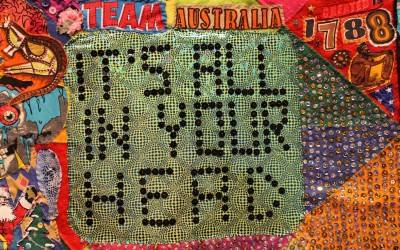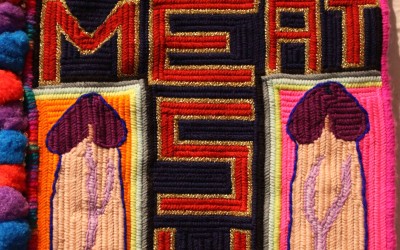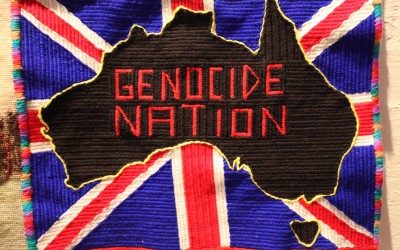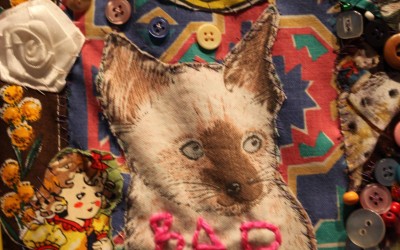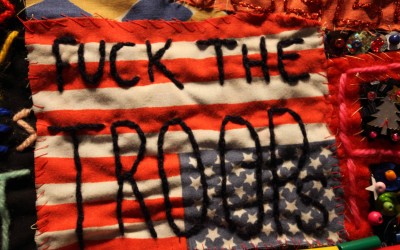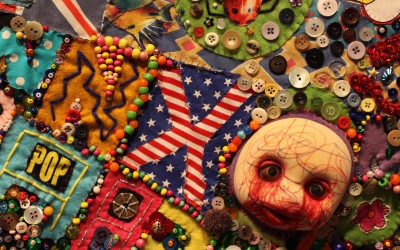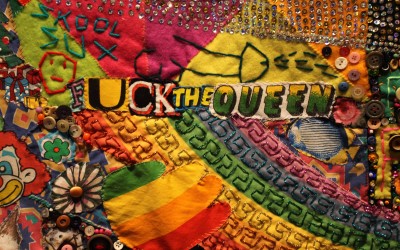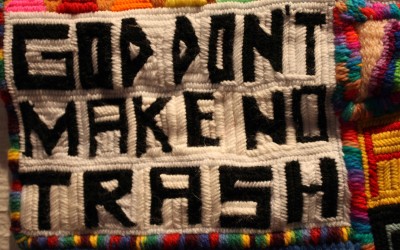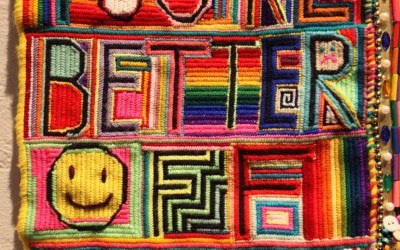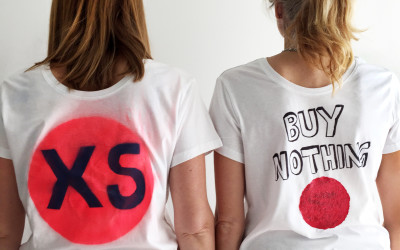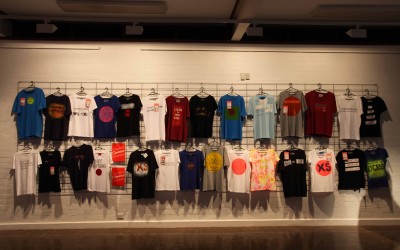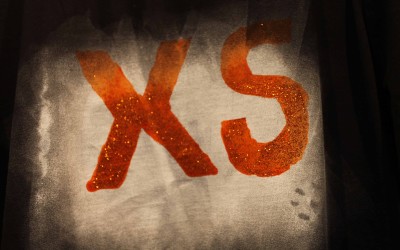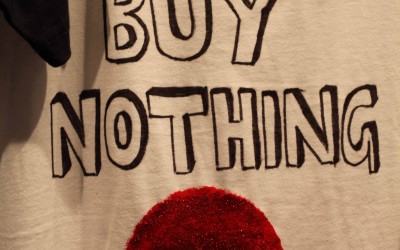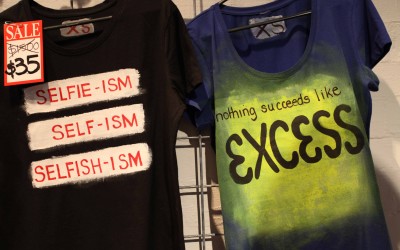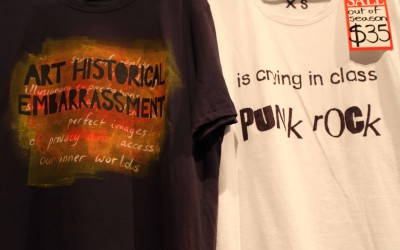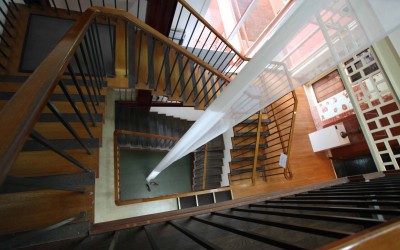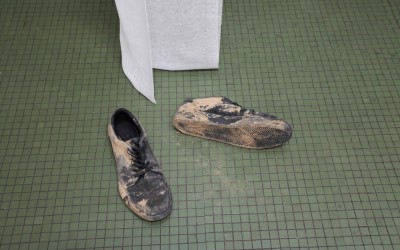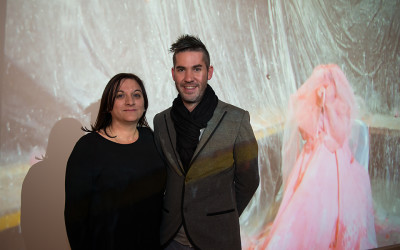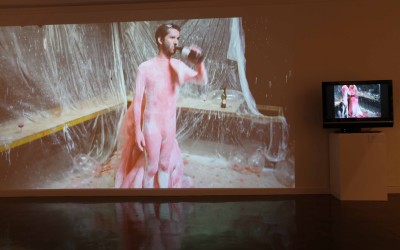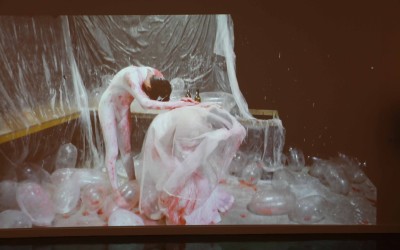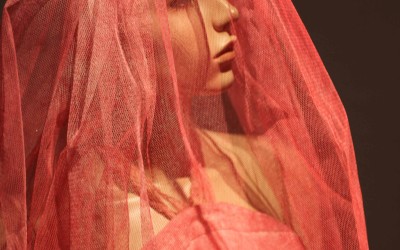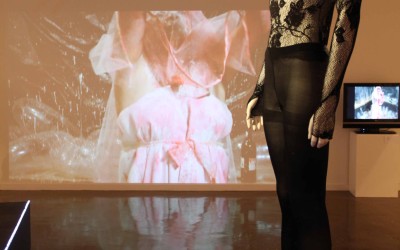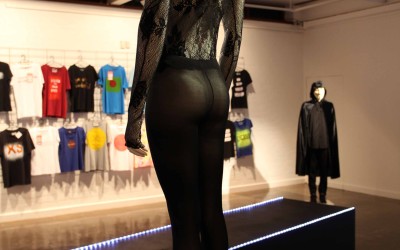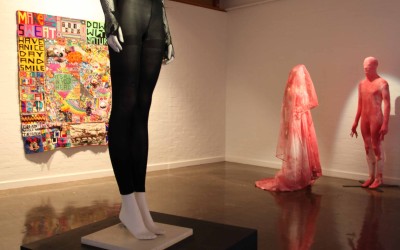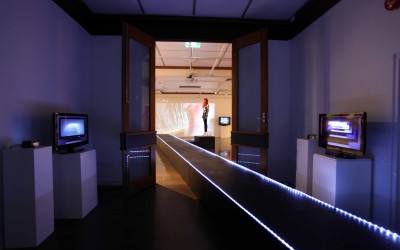May 2015 Work
Mildura Arts Centre Exhibition
Occupying both upstairs spaces at MAC, Galleries 3 and 4, the xs collective of 11 artists – Paul Yore (Neon Parc, Melbourne), Stuart Walsh, Kerryn Sylvia, Rohan Morris, Danielle Hobbs, Kristian Häggblom, Laura Freitag, Dan Downing, Kate Cotching, Rosina Byrne and Geoffrey Brown – used an array of installation art devices, ranging from intricately woven and embroidered textile, through politically-charged street art imagery and popular culture costume, to video performances and a fully operational drinks bar; to challenge us all to confront our own excesses, simply by having them reflected back at us.
This was further played out and emphasised on the Opening Night on Thursday May 7 2015, with the public being invited to come dressed excessively.
Coordinated by Kate Cotching, the two gallery spaces were linked by an 18m long (90cm wide and 50cm high) black catwalk that ‘slashed’ at an angle through the inter-linking double doorway, providing a unique architectural intervention, which, with LED strip-lighting each side, resembled a runway.
The xs collective project at Mildura Arts Centre interrogated human excess in the context of a rapacious neoliberal economic order, in which artists are finding it increasingly difficult to resist co-option by and collusion with the supremacy of capital. It also embraced the challenges and issues inherent in collective practice, reflecting on authorship, curatorial responsibility and the group exhibition format.
By examining and problematising collective practice, where the expectation of harmony often precluded healthy debate, and successful collaboration prohibited any possibility of failure, the xs collective became as interested in exploring the risks associated with – and the diversity inherent in – collective practice, as it was in maintaining collective unity. The xs collective artists brought diverse and heterogeneous approaches to authorship across socio-cultural, political and gender lines, while reflecting on excess thematically in the production of their work. Here, the paradoxes and risks that this process uncovered became crucial to the creation of the conditions for multiplicity, to the variety borne of eclecticism, and to the often unscripted but healthy tension between collaborators and provocateurs.
In order to investigate the customary and ritualised workings of the operating system of art, and in particular its medium of the exhibition, the xs collective sought, through socially inventive and provocative means, to ambiguously accentuate that system’s embeddedness in capital. It did this primarily at the well-attended opening by engaging people – many of whom had come dressed excessively – in a night of cosplay frivolity and performance that deliberately belied the seriousness of the political critique inherent in the work itself.
At the opening, Laura Freitag worked with notions of anonymity and body-as-object in performing an endurance work that lasted several hours while concurrently recording the gaze of her onlookers in order to retrospectively examine their behaviour. This audience behaviour proved uncanny, even on the night, with people largely ignoring her and assuming she was a static mannequin (again, anecdotally, this was admitted by many people at the time, that they had simply ignored her). In fact she replaced herself with a look-alike mannequin for the remaining two months of the show – without a noticeable change in onlooker behaviour. For Freitag, this vindicated her work; that, by combining stasis with anonymity, she could become completely absent. Instead of having to, as she said in her statement “endure the gaze of onlookers”, she became in a sense invisible to them.
Of the eleven artists in this collective show, Paul Yore’s textile work IT’S ALL IN YOUR HEAD stood out as the most confrontational and excessive. “Richly embellished with sequins, buttons and beads, and emblazoned with cryptic slogans, the absurdist subject matter was drawn from a multitude of disparate sources – from Australiana and pop culture to homoerotic and classical themes.” Yore’s statement continues:
“The ambiguous scene takes place in a nightmarish, collapsing world of language, in which a mutant koala apprehends an anxious figure. An allegory for the uneasy position of the citizen in relation to the increasingly autocratic and corporatised state, the work is partly a solemn archaeology of the desolate, soulless landscape of white middle-class Australia, and partly the erection of a juvenile, highly personalised queer mythology.
Yore examines the messed-up capitalist nightmare of Australian society, cynically rejects it and reorders its tropes and symbols of authority into a highly idiosyncratic, sarcastic wonderland of sorts, where boundaries between the ‘real’, shiny outside world and the interior psychological panorama intermingle.”
This ‘nightmarish, collapsing world of language’ included Australian obscenities reflected back at us as if to deliberately offend – quite the opposite of the more subtle subversion and covert ambiguity of Deleuze and Guattarian minor language. Such slogans included: FUCK AUSTRALIA, FUCK THE TROOPS, FUCK THE QUEEN, GENOCIDE NATION and STATE OF CULTURAL GENOCIDE – all reminiscent of the confrontational anti-establishment anarchism of the 20th century punk subculture, apparently, however, reinterpreted to suggest the current government’s penchant for political slogans over informed and open public debate. Yore obviously delights in exposing ‘the messed-up capitalist nightmare of Australian society’ and in asserting his own ‘highly personalised queer mythology’.
Stuart Walsh used a challenging mix of confusion, ambiguity and détournement to provoke our senses in his highly political textile banners. Using the stark black and white of Islamic State flags, Walsh questioned the politically constructed fear meant to deliberately tap into our deepest xenophobia, a fear then used to justify the erosion of our civil liberties:
“What is Al Qaeda? What is ISIS, ISIL or Daesh? What is the Taliban? What is the difference between Sunni and Shia Muslims? Why are Australians killing people in the Middle East and demonising Islam? How did we become involved in a war, in a region most of us have no real knowledge of and have never been to? We appear to be under attack from terrifying foreign phantasms – imagined or exaggerated enemies. What is this mysterious threat? What dark menace from the east lays waiting to attack our privileged world? When, if ever, will they strike and how…or is the war on terror a farce?”
Adding a performative element to his work on the opening night, Walsh dressed excessively and convincingly, wearing a combination of Al Qaeda outfit, gasmask and several bandoliers – and appropriately pairing with an authentically dressed Iraqi immigrant artist.
Several other xs collective artists also used textiles in their works, in quite different ways and contexts. Kerryn Sylvia and Danielle Hobbs hand painted and printed dozens of t-shirts in a large wall installation titled CLEARANCE, which spoke of excessive consumerism and the bourgeois narcissism prevalent in popular culture as a product of the embedded ego-cult of neoliberalism. The fact that these shirts were actually available for sale completed the work.
Sylvia used the Mildura Arts Centre 9.5m stairwell for her poignant work The Fall, a gestural response to the then current and traumatic event in which her son fell almost the height of the stairwell, an excessive 8m, and survived without major damage. It explored the “inherent qualities of objects and how their placement in a specific space can work as a first and recurring reaction to dealing with events we cannot change or hope to control”. By suspending a simple bolt of muslin from upper ceiling to bottom floor level and placing her son’s mud-covered shoes at its base (the ones he was wearing at the time), Sylvia left it to us to imagine and complete the work. Sylvia’s other collaborative work We are more than our bodies, this time with collective artists Rosina Byrne and Laura Freitag, a wall-sized video of an earlier performance led by Byrne, was an entreaty to our excessively consumerist society to recognise women as more than commodities and objects of idealised beauty.
Textiles were also the medium of Kate Cotching in her two works The maker and the user and Humanity lost (work in progress). In The maker and the user, Cotching juxtaposed lace-subtle images of women in sweatshops with the mass-produced products of those factories, products that we all buy from the faceless brand-name companies who do the exploiting. We are thus confronted with the truth: that these workers are underpaid and exploited and that we are complicit in choosing to pay less. But will we act; will we choose to pay more?
Cotching’s Humanity lost (work in progress), references the lives lost and still being lost to capital punishment in some countries and the Amnesty International campaign against the death penalty – indeed, a work in progress!
Kristian Häggblom, in his installation Surveillance Surveyed, chose to compulsorily capture all people who passed between opposing video cameras and TV monitors in two closed-circuit video loop recordings. As the cameras were mounted in the doorway between the two galleries (below), people were automatically recorded on video tape and concurrently displayed on opposing monitors in an infinite real time loop, and could choose whether to waive at themselves and acknowledge the lens – or not. Our awareness of the excessive surveillance in our lives, and our apparent willingness to tolerate its intrusion, are brought into sharp focus – as is the politically constructed fear that has lead to this intrusion.
Using found objects in the form of alcohol packaging acquired through the ‘exploration’ of various brands, Dan Downing created the installation Explorer, which was used on the opening night as a fully functioning drinks bar. Downing interrogated the excessive alcohol consumption that often inflicts sufferers of clinical depression and explored the intimacies of that depression through the use of alcohol branding and packaging, as well as through the architectural and psycho-spatial associations with public bars and places of alcohol consumption. Bourriaud’s Relational Aesthetics were also invoked in the highly successful use of the work as a drinks bar, as a focus of social engagement with the show.
Rohan Morris and Rosina Byrne used a wall-sized video of their previous xs collective performance, Inter-action, together with the props from that performance, to again question the expectations placed on women from traditional European cultures to ‘keep their virginity for their husbands’ (while the male expectation is the reverse), and the psychological toll acutely felt by gay men who are still ostracised in regional Australia.
Geoffrey Brown’s works for this show were also videos of previous performances. The original live performance of Drum beat incorporated timpani, mp3 with sound amplification, video backdrop and lighting, and sought to emphasise – through mimesis and overidentification – the foreboding signs of extremism and fascism currently emerging in our political and social systems. In addition to various percussive instruments, the work used the cinematic backdrop of a Leni Riefenstahl Nuremberg Rally film and a deliberately loud soundtrack of a Hitler speech, as the setting for an incessant drum beat. Brown chose to dress as a Nazi on the evening of the opening, to underscore the reality of the threat extremism poses to our Westminster system of parliamentary democracy, and to our tolerance, sense of social justice, compassion and the preservation of our civil liberties. Brown’s second work, We’ll be an Honest Government sought to anonymously enact the cognitive dissonance between what politicians promise and what they deliver.

